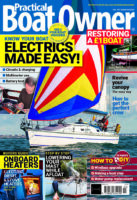A screwdriver, a straight edge and a good set of eyes are all that’s required for a basic rig check. Gordon Bonney of Performance Rigging explains all...
There are plenty of ways that a mast or its rigging can fail, but there are often key telltale signs that a problem is about to develop. Fatigue is one of the biggest factors when it comes to the issues that lead to problems and lack of articulation is usually where the trouble starts.
So, a good visual rig check where you can move each component around can go a long way to identifying potential problems. And it is for this reason that, while it is possible to perform a rig check with the mast in situ, it is more effective to take a good look when it is out of the boat when the rigging is slack and you can get a much better look at the fittings and the area around them. Here’s what to look for in your rig check.
1 – Masthead
Take a good look around the masthead unit. Some are welded, some are bolted in; either way look closely for cracks around the loaded areas. Check for wear and excessive slack around the areas where the rigging is attached. Make sure all split pins are in place and properly opened out. Also check for chafe around the masthead area. Aluminium is relatively soft and it doesn’t take much to damage it and produce a sharp edge that will chafe halyards quickly.

2 – Spreader area
This is another high-load area with plenty going on. Check that the spreaders don’t have excessive play and that they are clamped to the rigging at their outer ends to ensure they sit at the same height on each side. Check the rigging attachments at the mast end carefully for cracks and excess wear. Check that the diagonal stays are able to align properly and articulate. If they don’t they can be overloaded and fail.

3 – Rigging checks
Swage terminals are the most common way of terminating rigging and while they are very reliable when made correctly, they can also cause a stress raiser where the wire enters the swage fitting. If the end fitting doesn’t align properly high loads can be put on the wire where individual strands can fail just inside the stem of the terminal. Look carefully for any signs of broken strands. Toggles, tangs and T-terminal attachments need to be looked at carefully for signs of wear and cracks.

4 – Lower mast area
Run your fingers along the mast wall on either side of halyard exits. Any bumps either side of the exit may be an indication that the mast has been over bent and stressed. Bumps could be a sign of buckling in the mast wall. High load areas such as the boom and kicker goosenecks also need carefully checking for signs of wear.

5 – Heel plug
Whether it be keel-stepped or deck-stepped the heel plug at the bottom of the mast has to support all the compression in the rig. The alloy mast tube sits on a lip on the cast alloy plug. If there is corrosion between the mast wall and the plug it can swell the mast wall and risk overloading other areas of the mast tube.

6 – Sheaves and corrosion
Most halyard sheaves are made of high-load plastics which make them less likely to corrode and jam, but seized halyard sheaves are still very common, especially if a bearing and/or its sheave pin has worn. This can lead to a series of issues including excess chafe problems with halyards. Check sheaves run freely and investigate if they don’t. Given that masts are generally built from aluminium alloy and steel fittings corrosion can be an issue, particularly if the two materials are not insulated. Applying zinc chromate paste to mast wall fittings before they are re-fastened is a simple solution to this problem.

Our How To video series is brought to you in association with GJW Direct.



